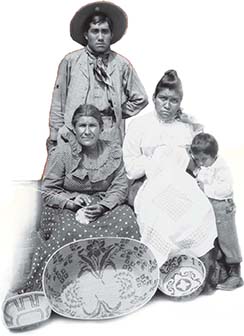SECTION 3: The Struggle Against Discrimination

▲ Cuero family, Warner Springs, California, 1904
WITNESS HISTORY  AUDIO
AUDIO
Voices of Protest
The sympathy that reformers felt for the plight of the poor did not often extend to minorities. In 1912, Progressive journalist Samuel Bryan wrote an investigative article about Mexican immigrants. Displaying a common bias, Bryan concluded that the immigrants did not work hard enough. Yet, he was forced to admit that Mexican Americans faced discrimination. He wrote:
“[Mexican Americans] are now employed to a considerable extent in the coal mines of Colorado and New Mexico, in the ore mines of Colorado and Arizona, in the smelters of Arizona, in the cement factories of Colorado and California, … and in fruit growing and canning in California…. Where they are employed in other industries, the same wage discrimination against them as was noted in the case of railroad employees is generally apparent.”
—Samuel Bryan, The Survey, September 1912
Objectives
- Analyze Progressives’ attitudes toward minority rights.
- Explain why African Americans organized.
- Examine the strategies used by members of other minority groups to defend their rights.
Terms and People
- Americanization
- Booker T. Washington
- W.E.B. Du Bois
- Niagara Movement
- NAACP
- Urban League
- Anti-Defamation League
- mutualistas
NoteTaking
Reading Skill: Main Idea and Details Outline the section’s main ideas and details.
- The Struggle Against Discrimination
Why It Matters Prejudice and discrimination against minorities continued even as the Progressive Movement got underway. But in the spirit of Progressivism, African Americans, Latinos, Catholics, Jews, and new immigrant groups worked to help themselves. Their efforts paved the way for the era of civil rights that would follow decades later. Section Focus Question: What steps did minorities take to combat social problems and discrimination?
Progressivism Presents Contradictions
The Progressive Era was not so progressive for nonwhite and immigrant Americans. Most Progressives were white Anglo-Saxon Protestant reformers who were indifferent or actively hostile to minorities. They tried to make the United States a model society by encouraging everyone to follow white, middle-class ways of life.
Social Reform or Social Control?
Settlement houses and other civic groups played a prominent role in the Americanization efforts of many Progressives. While they taught immigrants English, their programs also tried to change how immigrants lived. They advised immigrants how to dress like white middle-class Americans and pushed them to replace the foods and customs of their homelands with




